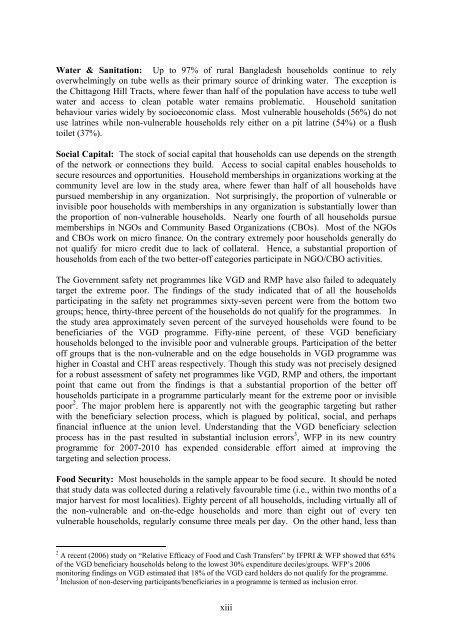RURAL BANGLADESH - PreventionWeb
RURAL BANGLADESH - PreventionWeb
RURAL BANGLADESH - PreventionWeb
You also want an ePaper? Increase the reach of your titles
YUMPU automatically turns print PDFs into web optimized ePapers that Google loves.
Water & Sanitation: Up to 97% of rural Bangladesh households continue to rely<br />
overwhelmingly on tube wells as their primary source of drinking water. The exception is<br />
the Chittagong Hill Tracts, where fewer than half of the population have access to tube well<br />
water and access to clean potable water remains problematic. Household sanitation<br />
behaviour varies widely by socioeconomic class. Most vulnerable households (56%) do not<br />
use latrines while non-vulnerable households rely either on a pit latrine (54%) or a flush<br />
toilet (37%).<br />
Social Capital: The stock of social capital that households can use depends on the strength<br />
of the network or connections they build. Access to social capital enables households to<br />
secure resources and opportunities. Household memberships in organizations working at the<br />
community level are low in the study area, where fewer than half of all households have<br />
pursued membership in any organization. Not surprisingly, the proportion of vulnerable or<br />
invisible poor households with memberships in any organization is substantially lower than<br />
the proportion of non-vulnerable households. Nearly one fourth of all households pursue<br />
memberships in NGOs and Community Based Organizations (CBOs). Most of the NGOs<br />
and CBOs work on micro finance. On the contrary extremely poor households generally do<br />
not qualify for micro credit due to lack of collateral. Hence, a substantial proportion of<br />
households from each of the two better-off categories participate in NGO/CBO activities.<br />
The Government safety net programmes like VGD and RMP have also failed to adequately<br />
target the extreme poor. The findings of the study indicated that of all the households<br />
participating in the safety net programmes sixty-seven percent were from the bottom two<br />
groups; hence, thirty-three percent of the households do not qualify for the programmes. In<br />
the study area approximately seven percent of the surveyed households were found to be<br />
beneficiaries of the VGD programme. Fifty-nine percent, of these VGD beneficiary<br />
households belonged to the invisible poor and vulnerable groups. Participation of the better<br />
off groups that is the non-vulnerable and on the edge households in VGD programme was<br />
higher in Coastal and CHT areas respectively. Though this study was not precisely designed<br />
for a robust assessment of safety net programmes like VGD, RMP and others, the important<br />
point that came out from the findings is that a substantial proportion of the better off<br />
households participate in a programme particularly meant for the extreme poor or invisible<br />
poor 2 . The major problem here is apparently not with the geographic targeting but rather<br />
with the beneficiary selection process, which is plagued by political, social, and perhaps<br />
financial influence at the union level. Understanding that the VGD beneficiary selection<br />
process has in the past resulted in substantial inclusion errors 3 , WFP in its new country<br />
programme for 2007-2010 has expended considerable effort aimed at improving the<br />
targeting and selection process.<br />
Food Security: Most households in the sample appear to be food secure. It should be noted<br />
that study data was collected during a relatively favourable time (i.e., within two months of a<br />
major harvest for most localities). Eighty percent of all households, including virtually all of<br />
the non-vulnerable and on-the-edge households and more than eight out of every ten<br />
vulnerable households, regularly consume three meals per day. On the other hand, less than<br />
2 A recent (2006) study on “Relative Efficacy of Food and Cash Transfers” by IFPRI & WFP showed that 65%<br />
of the VGD beneficiary households belong to the lowest 30% expenditure deciles/groups. WFP’s 2006<br />
monitoring findings on VGD estimated that 18% of the VGD card holders do not qualify for the programme.<br />
3 Inclusion of non-deserving participants/beneficiaries in a programme is termed as inclusion error.<br />
xiii












![View full document [PDF 988.55 KB] - PreventionWeb](https://img.yumpu.com/47733942/1/184x260/view-full-document-pdf-98855-kb-preventionweb.jpg?quality=85)
![View full document (in French) [PDF 4.96 MB] - PreventionWeb](https://img.yumpu.com/47223870/1/184x260/view-full-document-in-french-pdf-496-mb-preventionweb.jpg?quality=85)


![View full document [PDF 25.02 MB] - PreventionWeb](https://img.yumpu.com/44204570/1/190x234/view-full-document-pdf-2502-mb-preventionweb.jpg?quality=85)
